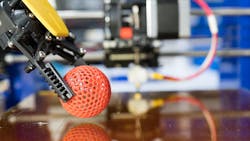The Potential Benefits of 3D-Printed Prototypes
This article was updated April 10, 2023. It was originally published Sept. 28, 2018.
RELATED
3D Printing Goes Big-Time for Small Production Runs
Best practices for Using Rapid Prototypes
ASME Publishes Updated Standard for 3D Printing
3D printing can be an effective, low-cost way to build prototypes, especially when you consider all the competitive advantages companies can get from it—assuming they know what they’re doing. Here are five distinct benefits.
1. Better Designs
Prototypes are used to test designs in terms of functionality, appearance, ergonomics, reliability, and a host of other product parameters critical to the final product’s success or failure in the marketplace. 3D printing lets design teams quickly and inexpensively build and test several prototypes and what they discover opens the door to further refinements, and ultimately better designs.
2. Manufacturing-as-a-Service
Software-as-a-Service (SaaS) has been around at least a half a century, but it has gotten more popular over that time and is now relatively commonplace. Now, largely thanks to 3D printing, we have Manufacturing-as-a-Service (MaaS). Companies are popping up that can provide design and production capabilities to individuals and companies that might lack the expertise or manufacturing capabilities.
These MaaS firms can also handle several clients simultaneously, manufacturing several completely different items at once. They do this with a host of different types of 3D printers, each with distinct advantages for different products. For example, companies that can quickly turn out low-volume tooling and fixtures are becoming the new normal.
MaaS is just another way 3D printing has made manufacturing more accessible.
3. Less Waste
Governments across the globe are putting in place stricter laws regarding materials and waste. Today, the average waste from a traditional manufacturing accounts for 20% of the raw materials purchased to make parts. 3D printing cuts that figure in half, to below 10%, and it also reduces carbon emissions.
As 3D printing goes from prototyping to production, a move many companies are trying to make, the returns in terms of less waste and fewer carbon emissions will grow. Of course, 3D printing has to improve in terms of high-volume production and its ability to quickly make functional parts out of a variety of materials, including metals.
4. Better Use
Manufacturing operations are not that efficient, despite all the engineering that goes into improving efficiency. For example, in the U.S., manufacturing use is only 75%. That means one-fourth of the materials and processes bought and paid for are not used efficiently. This is because traditional production methods include processes such as injection molding and die casting. They need specialized and expensive equipment that lack the versatility of 3D printing.
5. Encourage Innovation
One of the most important potential benefits of 3D printing is that it can improve the final design by giving engineers a string of prototypes, each an improvement over the previous one as the design team learns more.
In traditional manufacturing, different parts get assembled into the final product. 3D printing removes these constraints. 3D printers let companies build complex products as a whole without needing any additional design elements.
Because there are fewer constraints to the design projects, designers can think more freely.
Overcoming Challenges
There are still several hurdles 3D printing must get over. For example, the higher cost of 3D printing materials and equipment is keeping 3D printing from becoming standard in manufacturing operations. There is also the challenge of mass production. 3D printing might work for a widget if only 100 widgets are needed. But if 100,000 widgets are needed, it might be as helpful.
Despite these problems, technology pushes forward. 3D printing is being used around the world to create new prototypes that benefit everyone. We can only expect to see more improvements in the process.
Wendy Dessler was an outreach manager at 3ERP, a rapid-prototyping firm, when this was article was originally published.
About the Author
Wendy Dessler
Outreach Manager
Wendy Dessler is a super-connector with 3ERP who helps businesses with building their audience online through outreach, partnerships, and networking. Wendy frequently writes about the latest advancements in the SaaS world and digital marketing.
